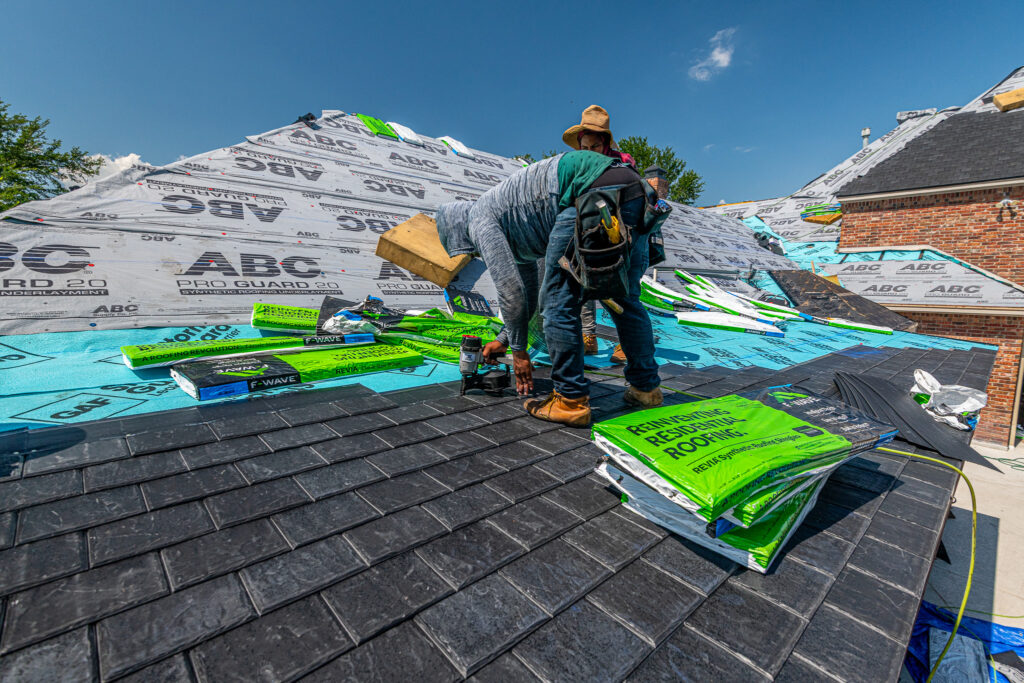Posted by Ryan Stephens on Monday, August 11, 2025
F-Wave Shingles
Quick F-Wave Shingles story: Rick lives in the Dallas–Fort Worth area and is no stranger to the Texas sun and storm seasons. His 20-year-old asphalt roof was showing its age, with curling shingles, some hail damage, frequent repairs, and constant worry with every severe weather alert. He was tired of patch jobs and rising insurance premiums.
Like most homeowners, Rick assumed asphalt shingles were his only option, since they’re so common in Texas. He knew he couldn’t afford the ultra-premium options like real slate roof shingles or clay tile.

When Rick checked his insurance deductible, he realized he was going to have to pay thousands of dollars up front for a roof replacement. The thought of needing to pay that much money just to replace his shingles with something that would break during the first hailstorm made him sick to his stomach.
We live in the age of modern tech. AI can do almost anything we ask it to. We have electric cars and solar power. Why haven’t we developed a cutting-edge product that can withstand the extreme weather conditions Texas can throw at it?
That’s when he discovered F-Wave shingles, a next-generation roofing solution built for the Texas climate. The difference?

Step 1: Understand Today’s Roofing Needs
What’s at stake right now?
- Current roof condition: Is your roof aging, leaking, or losing granules?
- Weather exposure: Do hail, high winds, heat, or rapid aging affect durability?
- Insurance costs: Are premium hikes or coverage limitations tied to your existing roof?
Rick’s roof was leaking in spots after hailstorms, and his insurer flagged the risk, meaning higher premiums or partial non-coverage. He needed a solution more resilient than traditional shingles.
Step 2: Consider Where You’re Headed
What’s just ahead on the horizon?
- Longevity & maintenance: Do you want a low-maintenance roof that lasts decades?
- Energy efficiency: Are you looking to reduce cooling costs under the harsh Texas sun?
- Resale value & insurance perks: Could a high-performance roof boost home value or earn premium rebates?
Rick was planning on staying put long-term, but he also had solar panels in the future and wanted a roof that would work seamlessly with them. Plus, he discovered that many insurers give discounts for impact- or wind-resistant roofs like F-Wave.
Step 3: Protect What Matters Most
What matters most under those shingles?
- Your home’s structure & contents
- Comfort & energy bills
- Budget & long-term peace of mind
F-Wave shingles offer strong resistance to Texas hail, blistering sun, and fierce winds, providing a durable shield for your home. For Rick, it meant fewer repairs, cooler temperatures indoors, and seeing long-term insurance savings. Most importantly, it reduced stress and gave him the certainty he needed to plan for tomorrow.
F-Wave Shingles: A Roof Worth Trusting
F-Wave isn’t just another roofing product; it’s a smart investment for Texas weather realities. Durable, energy-efficient, and backed by modern design, it’s a proactive choice, not just a reactive fix.
Rick’s Outcome and What You Can Do Next
Rick upgraded to F-Wave shingles with confidence. He’s seen:
- Fewer costly repairs
- Noticeably cooler attic temperatures
- A better insurance rate and a roof built to last
You don’t have to wait for the next Texas storm to strike before taking action. If your roof is over a decade old—or just underperforming ask yourself: Is it time to reinforce what matters?
Schedule a roof consultation today and explore how F-Wave shingles can bring long-term peace and protection to your home.
F-Wave Shingles FAQs – Frequently Asked Questions
What exactly makes F-Wave shingles a better fit for Texas than regular asphalt shingles?
They’re engineered to resist 130MPH winds, heat, and large hail, key stresses in Texas roofing. That means fewer repairs, fewer leaks, and a longer lifespan.
Will choosing F-Wave shingles actually lower my insurance costs?
Many homeowners with impact-resistant or high-wind-rated roofs see reduced premiums or receive insurer incentives.
Are these shingles more expensive to install? Is it worth it?
They may cost more upfront, but the long-term savings in repairs, energy bills, and insurance commonly outweigh the initial cost.
How long can I expect an F-Wave roof to last in Texas?
With their enhanced durability, these shingles can last 25 to 40 years—often enduring far past traditional roofing options.
Topics: F-Wave shingles, hail-resistant roof,

